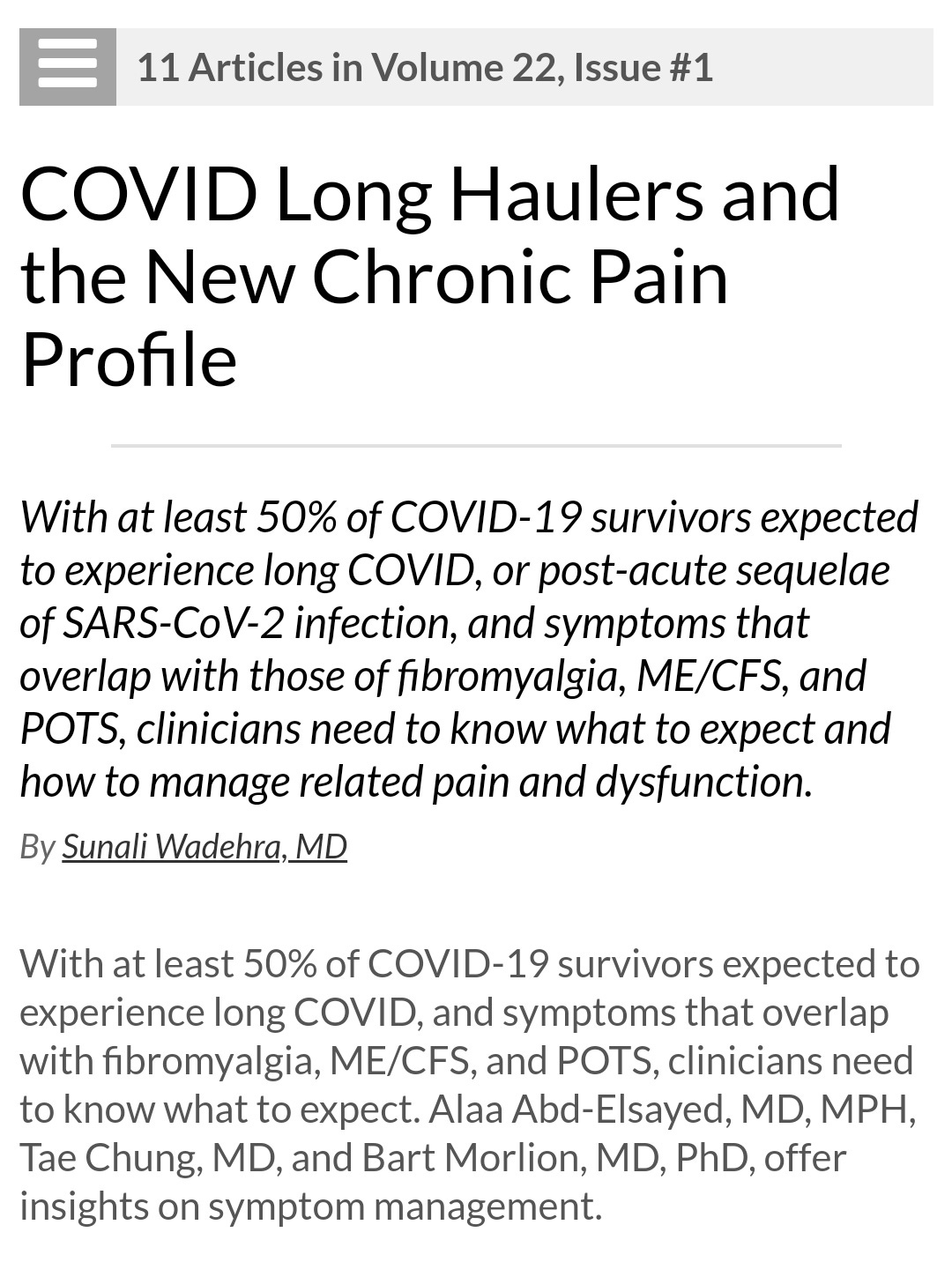Long COVID Symptoms Linked to Effects on Vagus Nerve
It's beginning to look a lot like HIV
Any extracts used in the following article are for non commercial research and educational purposes only and may be subject to copyright from their respective owners.
“Researchers from the University Hospital Germans Trias i Pujol in Spain performed a study to look at vagus nerve functioning in long COVID patients. Among 348 patients, about 66% had at least one symptom that suggested vagus nerve dysfunction. The researchers did a broad evaluation with imaging and functional tests for 22 patients in the university’s Long COVID Clinic from March to June 2021.
Of the 22 patients, 20 were women, and the median age was 44. The most frequent symptoms related to vagus nerve dysfunction were diarrhea (73%), high heart rates (59%), dizziness (45%), swallowing problems (45%), voice problems (45%), and low blood pressure (14%).
Almost all (19 of 22 patients) had three or more symptoms related to vagus nerve dysfunction. The average length of symptoms was 14 months.Six of 22 patients had a change in the vagus nerve in the neck, which the researchers observed by ultrasound. They had a thickening of the vagus nerve and increased “echogenicity,” which suggests inflammation.What’s more, 10 of 22 patients had flattened “diaphragmatic curves” during a thoracic ultrasound, which means the diaphragm doesn’t move as well as it should during breathing, and abnormal breathing. In another assessment, 10 of 16 patients had lower maximum inspiration pressures, suggesting a weakness in breathing muscles.
Eating and digestion were also impaired in some patients, with 13 reporting trouble with swallowing. During a gastric and bowel function assessment, eight patients couldn’t move food from the esophagus to the stomach as well as they should, while nine patients had acid reflux. Three patients had a hiatal hernia, which happens when the upper part of the stomach bulges through the diaphragm into the chest cavity.
The voices of some patients changed as well. Eight patients had an abnormal voice handicap index 30 test, which is a standard way to measure voice function. Among those, seven patients had dysphonia, or persistent voice problems.”
Full article:
https://www.webmd.com/lung/coronavirus
In this paper they are treating HIV associated depression by stimulating the impaired vagus nerve. Note the pathology involved and other sequalae.
BDNF = “Brain-Derived Neurotrophic Factor”, and is referred to several times.
The common link here is GP120 and the cholinergic antiflammatory pathway, and we looked into the bungarotoxin effects previously.
May we spredict similar outcomes in the spike protein injured, including depression, with similar long term elevated inflammatory cytokine levels?
“Anhedonia is the inability to feel pleasure. It's a common symptom of depression as well as other mental health disorders. Most people understand what pleasure feels like. They expect certain things in life to make them happy.”
“The potential role of vagus-nerve stimulation in the treatment of HIV-associated depression: a review of literature' (2017)
Abstract
Depression is the most common comorbidity and neuropsychiatric complication in HIV. Estimates suggest that the prevalence rate for depression among HIV-infected individuals is three times that of the general population. The association between HIV and clinical depression is complex; however, chronic activation of inflammatory mechanisms, which disrupt central nervous system (CNS) function, may contribute to this association. Disruptions in CNS function can result in cognitive disorders, social withdrawal, fatigue, apathy, psychomotor impairment, and sleep disturbances, which are common manifestations in depression and HIV alike. Interestingly, the parasympathetic system-associated vagus nerve (VN) has primary homeostatic properties that restore CNS function following a stress or inflammatory response. Unfortunately, about 30% of adults with HIV are resistant to standard psychotherapeutic and psychopharmacological treatments for depression, thus suggesting the need for alternative treatment approaches. VN stimulation (VNS) and its benefits as a treatment for depression have been well documented, but remain unexplored in the HIV population. Historically, VNS has been delivered using a surgically implanted device; however, transcutanous VNS (tVNS) with nonsurgical auricular technology is now available. Although it currently lacks Food and Drug Administration approval in the US, evidence suggests several advantages of tVNS, including a reduced side-effect profile when compared to standard treatments and comparable results to implantable VNS in treating depression. Therefore, tVNS could offer an alternative for managing depression in HIV via regulating CNS function; moreover, tVNS may be useful for treatment of other symptoms common in HIV. From this, implications for nursing research and practice are provided.
Keywords: tVNS, depression, HIV, vagus nerve
“In both disorders, the dysregulation of neuroendocrine and neuroimmunological systems (via proinflammatory cytokines) produces a cascade of events resulting in attenuation of parasympathetic tone, pain, psychomotor disturbance, depression, alterations in mood and cognition, anhedonia, fatigue, apathy, cognitive disorders, dysregulated sleep, appetite disruptions, and social withdrawal. These symptoms are collectively referred to as “sickness behavior”, and are mediated by the vagus nerve (VN), along with being among the most prevalent symptoms in HIV with comorbid depression.9–12 Chronic disruption of the VN in response to stress leads to alterations in homeostasis via constant activation of the hypothalamic–pituitary–adrenal (HPA) axis and the sympathomedullary system.13 This activation increases cytokine production, and in turn induces a chronic “sickness state”. Contrarily, stimulation of the VN (particularly its α7 nicotinic pathway) can reverse the effects of sickness behavior by producing an anti-inflammatory effect via regulation of cytokine expression.”
Full paper:
https://www.ncbi.nlm.nih.gov/labs/pmc/articles/PMC5499939/#__ffn_sectitle
I can also expand on the GP120 associated pathophysiology in play as referred to in the above paper. If chronic pain is an issue for those with Long COVID, this is possibly a contributory factor.
Chronic Pain in HIV
“Chronic widespread pain is a common comorbidity of HIV infection and is associated with decreased quality of life and a high rate of disability. Chronic pain in people with HIV is multifactorial and influenced by HIV-induced peripheral neuropathy, drug-induced peripheral neuropathy, and chronic inflammation.”
https://www.ncbi.nlm.nih.gov/labs/pmc/articles/PMC7252379/
“HIV-1 gp120 Upregulates Brain-Derived Neurotrophic Factor (BDNF) Expression in BV2 Cells via the Wnt/β-Catenin Signaling Pathway” (2017)
Abstract
HIV-1 gp120 plays a critical role in the pathogenesis of HIV-associated pain, but the underlying molecular mechanisms are incompletely understood. This study aims to determine the effect and possible mechanism of HIV-1 gp120 on BDNF expression in BV2 cells (a murine-derived microglial cell line). We observed that gp120 (10 ng/ml) activated BV2 cells in cultures and upregulated proBDNF/mBDNF. Furthermore, gp120-treated BV2 also accumulated Wnt3a and β-catenin, suggesting the activation of the Wnt/β-catenin pathway. We demonstrated that activation of the pathway by Wnt3a upregulated BDNF expression. In contrast, inhibition of the Wnt/β-catenin pathway by either DKK1 or IWR-1 attenuated BDNF upregulation induced by gp120 or Wnt3a. These findings collectively suggest that gp120 stimulates BDNF expression in BV2 cells via the Wnt/β-catenin signaling pathway.
Keywords: BDNF; HIV-1 gp120; Microglia; Wnt/β-catenin signaling.
https://pubmed.ncbi.nlm.nih.gov/28560687/
Addendum:
https://www.practicalpainmanagement.com/pain/other/covid-long-haulers-new-chronic-pain-profile
Related:
https://twitter.com/Kevin_McKernan/status/1492881908786728966?s=19
Immune imprinting, breadth of variant recognition, and germinal center response in human SARS-CoV-2 infection and vaccination (2022)
https://www.cell.com/cell/fulltext/S0092-8674(22)00076-9?_return#fig7
SARS-CoV-2 Spike Targets USP33-IRF9 Axis via Exosomal miR-148a to Activate Human Microglia
https://doorlesscarp953.substack.com/p/sars-cov-2-spike-targets-usp33-irf9?r=if8o







